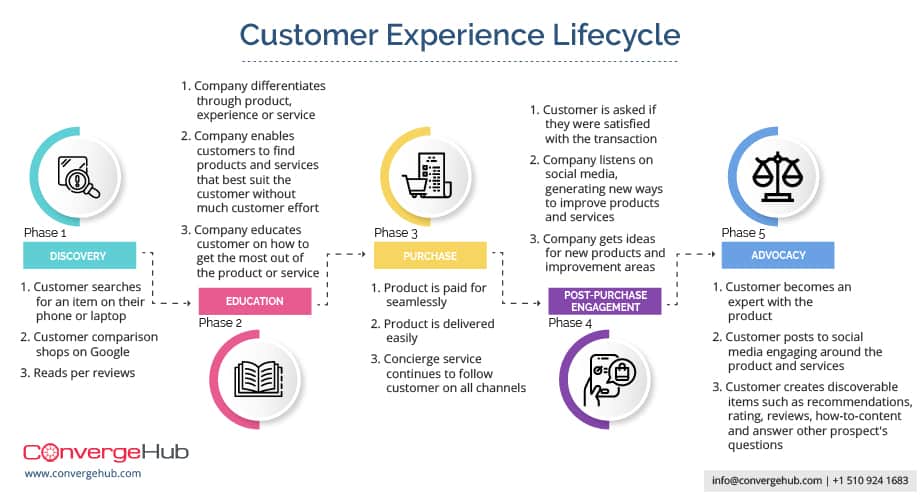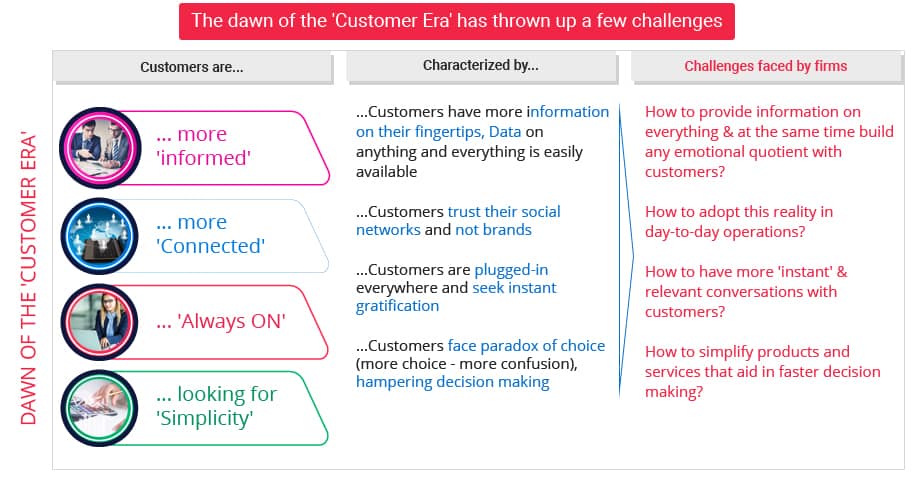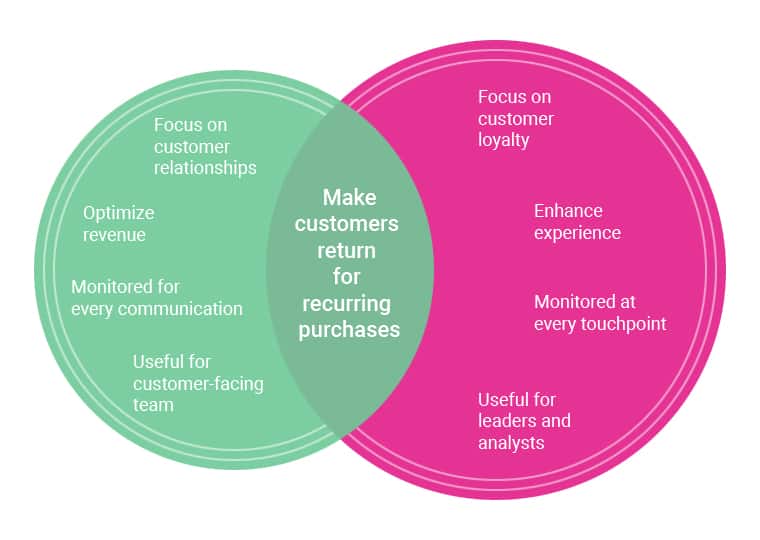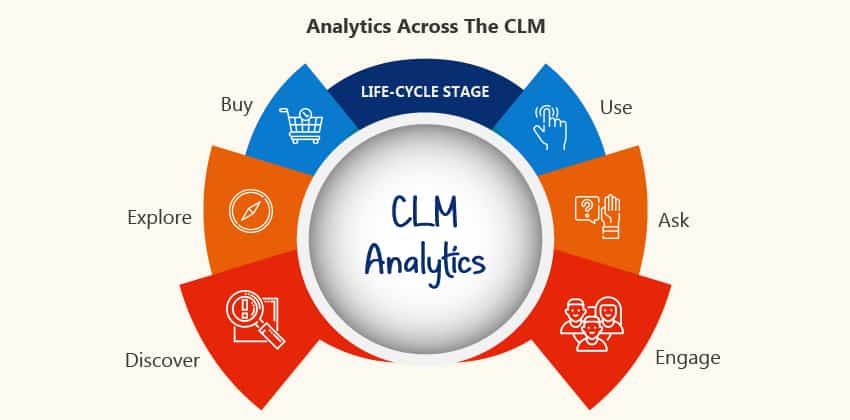
Customer Lifecycle Management or CLM is an effective way to cater to the evolving customer needs, soaring customer expectations, and shifting customer behavior. Its focus on understanding customer needs at various stages of her lifecycle and meeting those needs at the right moment helps businesses drive brand loyalty and advocacy.
Your existing customers are your huge assets. To run a successful business, you need to take care of them, understand their needs and meet them so that they remain loyal to your company. And yet, many small and medium business owners spend most of their efforts and resources on acquiring new customers instead of nurturing the existing ones.
Customer Lifecycle Management or CLM is the best way to nurture your existing customers, encourage them to buy more from you, and delight them. In this post, we take a deep dive into CLM and discuss various aspects of it-
Let's begin with answering: what is Customer Lifecycle Management? The customer lifecycle is a term used to describe the various stages a customer goes through with a company.
There is no standard definition of Customer Lifecycle Management. If you Google for 'Customer Lifecycle Management definition' you will get different results. There is no standard definition because each marketer has his own take on what constitutes a customer lifecycle, where it starts, and where it ends.
In the absence of a definition for CLM, let’s understand what Customer Lifecycle Management means. The customer lifecycle is a term that describes the different stages a customer goes through in its association with a company. It starts with the first time the customer hears about a company and continues till she uses the product or services.
The lifecycle can be broken down into five distinct stages as shown below: Discovery, Education, Purchase, Post-purchase engagement, and loyalty or advocacy.

At each stage, the customer needs and behavior varies. The idea behind CLM is to understand the customer’s behavior, predict her needs, and then prepare a plan to cater to these needs.
Life cycle management is not just a buzzword. More and more businesses are realizing the benefits of CLM and how it helps them understand customers’ needs, their behavior and help cater to them. From helping businesses create a detailed buyer persona, upsell and cross-sell to cultivate brand advocacy- lifecycle management helps businesses in several ways.
Customer Lifecycle Management is more important today than ever. The proliferation of smart phones and digital technologies has given birth to a new customer. One, who is informed, wants personalized experiences and is ready to shift brand loyalty if her expectations are not met. The key to impressing the new customer is to be proactive and personal. That’s where CLM comes in and provides you with data to get a 360-degree view of the customer.

CLM offers several key benefits to businesses including-
Many people confuse CLM and CRM. It can be really tricky as both CRM and Customer Lifecycle Management appear similar on the surface.
CLM and CRM both deal with customer data. Both also help sales and marketing teams in their various activities like lead management, customer segmentation, customer engagement, and email automation, etc. But CLM and CRM are different as they provide different values to a business.
The core focus of CRM software is to capture customer information and leverage it to build a relationship with the customer. The customer data can be used to personalize customer experiences and convert her from a prospect to a customer.
The core focus of the CLM, on the other hand, is to take a comprehensive approach towards a customer. It tracks a customer from her first engagement with your business and continues till she stays with your brand. The CLM software captures data around a customer’s lifecycle stage, her needs, and pain points at the stage and helps you meet them.
A CRM helps you build relationships with your customers whereas a CLM helps you leverage that relationship to get repeat business, referrals, and brand advocacy.

CRM vs CLM | ||
|---|---|---|
| CRM (Customer Relationship Management) | CLM (Customer Lifecycle Management) | |
| Focus | Customer relationships | Customer satisfaction and loyalty |
| Optimizes | Conversions | Repeat business and referrals |
| Monitors | Customer engagements | Customer lifecycle |
| Useful for | Sales & marketing | Entire business |
Many people often ask if a CRM can help in Customer Lifecycle Management. There aren’t many CRMs that can also do CLM but all CLM software have the capabilities of a CRM.
A CLM encompasses the entire business operations and aligns it with the lifecycle of customers whereas a CRM is limited to converting a prospect into a customer and building a relationship with them.
So, it is not possible to do Customer Lifecycle Management with a CRM.
Applying analytics across the customer lifecycle helps businesses to identify opportunities to extend the customer’s lifetime value and encourage value-generating behaviors. It helps businesses acquire more profitable customers through detailed buyer personas, granular customer segmentation, targeting, and reduces the cost of acquisition, drives cross-sell and upsell, and increases the lifetime value. Forrester has identified key customer analytics techniques-
| Technique | Description | Example |
|---|---|---|
| Classification/propensity | Used to predict an event or the likelihood of an occurrence of an event when there are two possible outcomes for the event | Churn prediction |
| Estimation/regression | Similar to classification models but used to estimate a continuous value versus a binary outcome | Cross-sell model |
| Clustering | Used to analyze data patterns and identify groupings of customers; new customers are subsequently scored against created clusters. | Behavioral segmentation model |
| Association/affinity | Used to detect associations between discrete events, products, or attributes | Market-basket analysis |
| Sequence | Used to detect associations over time | Path analysis |
| Life-cycle stage | Business objective | Analytical method |
|---|---|---|
| Discover | Profile customers Evaluate prospects Reach right prospects | Segmentation Lead scoring Customer look-alike targeting |
| Explore | Analyze customer response Optimize marketing mix Test marketing inputs | Offer/contact optimization Marketing mix modeling A/B and multivariate testing |
| Buy | Predict future events Expand wallet share Target accurately | Propensity models Cross-sell/upsell In-market timing models |
| Use | Drive deeper product use Understand context behind usage | Product and recommendation analysis Sentiment analysis |
| Ask | Learn about drivers of engagement Understand customer satisfaction | Engagement analysis Voice of the customer analysis |
| Engage | Manage defection of customers Personalize marketing efforts Maximize customer value Add context to behavior Increase depth of relationship | Churn models Next-best-action models Lifetime value models Customer location analysis Loyalty models |
The above graphic tells you the various analytical method that can be used at each stage of the customer lifecycle-

To effectively manage the customer lifecycle and gain benefits from it, it's necessary to define and understand the real Customer Lifecycle Management KPIs that should be monitored and measured across the lifecycle.
Many businesses make the mistake of picking website and social media metrics to measure the performance of their CLM. While these metrics are indicators of your performance, most of these highlights the effectiveness of your marketing, not the CLM. a successful CLM program should convert into more business, more valuable purchases, higher retention rate, and active brand advocacy. Here are some real Customer Lifecycle Management metrics you should monitor-

Many businesses find CLM to be easier said than done. Here are some common challenges in Customer Lifecycle Management you may face-

A good Customer Lifecycle Management platform will make it easy for you to orchestrate and manage your CLM process. However, selecting the right Customer Lifecycle Management software is important as the success of your CLM process will hugely depend on it.
Here’s what you should look for while selecting a Customer Lifecycle Management system-

ConvergeHub, our Customer Lifecycle Management software is designed for SMBs to design and orchestrate their CLM process. It helps you manage your entire business operations and manage your CLM from one single platform. Powered with advanced digital and data technologies, ConvergeHub offers powerful sales automation, precision marketing, enhanced customer support, and automated billing and payment tracking features. The bouquet of features helps you not only understand your customers better but also meaningfully engage with them at various stages of their lifecycle, personalize their experiences and nurture them towards brand advocacy. Click here to know more about ConvergeHub.
The customer lifecycle can be broken down into five stages- Discovery, Education, Purchase, Post-purchase engagement, and loyalty or advocacy.
The customer has unique needs in each of the life cycle stages. And life cycle management is all about understanding those needs and meeting them.
A B2B customer lifecycle is the time period for which a business is a customer of another business. It is similar to a B2C lifecycle. It has 5 stages: Awareness, Interest, Desire, Action, and Retention.
At each stage, the customer has a set of needs which a business must fulfill to take him to the next stage.
Software as a service (SaaS) works on a licensing and delivery model in which software is available on a subscription basis. A customer can purchase a SaaS solution in monthly, quarterly, and yearly packages. SaaS products have a different customer life cycle. It consists of awareness, consideration, free account signup/free trial, purchase, renewal, and referral.
In certain industries such as Financial Services, Banking, and B2B marketing, client lifecycle management is used instead of Customer Lifecycle Management. Both terms mean the same.
In Customer Relationship Management (CRM), the customer lifecycle is used to describe the various phases a prospect goes through to become a customer and the relationship onwards. It is normally divided into consideration, purchase, post-purchase and loyalty stages.
Customer lifecycle can be measured at each stage. Here are a few key metrics to measure customer lifecycle-